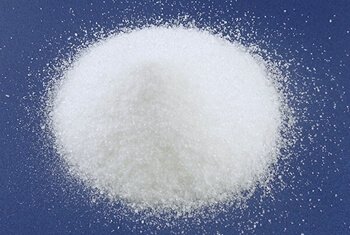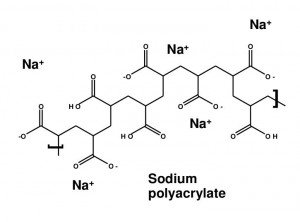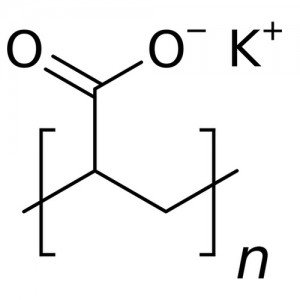Get Free Sample
Sodium polyacrylate is a functional polymer used in a variety of common products such as paper diapers, pets pad, water retaining material (to help the soil retain water), instant snow and so on. SuperAbsorbent Polymer is known for its superior absorbency:

polyacrylic polymer can absorb hundreds times its own weight in water.
Sodium polyacrylate starts out as a powder and as water absorbing polymer comes into contact with moisture, absorbent polymers swells into its gel form.
Unlike other absorbent materials, it’s not easy to squeeze the moisture out of this gel. This is what makes super absorbent polymers perfect for use in paper diapers — your baby can sit on it, roll around, sleep for hours in a wet diaper without leaks.
poly acrylic polymer, whose chemical formula is (C3H3NaO2)n, is a new type of functional polymer material and important chemical product. The solid product is white (or light yellow) block or powder, and the liquid product is colorless (or light yellow) viscous liquid.
Natureedit 
1. Appearance: The solid is white or light yellow block or powder, and the liquid is colorless or light yellow viscous liquid.
2. Density: 1.32g/mL, 25°C
3. Storage conditions: 2-8°C
4. Form: solid liquid
5. Proportion: 1.23
6. Discoloration of acid-base indicator pH range: 6-9
7. Stability: Stable under most conditions.
8. EPA chemical substance information: 9003-04-7
9. Chemical properties: tasteless. It swells with water and is easily soluble in aqueous caustic soda.
Potassium polyacrylate for agriculture is also called hydrogel polymer. Potassium polyacrylate is a polymer of potassium cation and acrylamide, with strong absorption capacity. This po
lyacrylate helps seedling germination and transportation with plants or seedlings. It is non-toxic, harmless and non-polluti
ng. Potassium polyacrylate mainly has the following functions:
-Increase the water retention capacity of the soil-Effectively reduce irrigation frequency
-Reduce water and nutrient loss
-Reduce evaporation rate to prevent moisture loss
-Improve the physical properties of the soil
-Enhance plant performance, especially in arid areas
-Reduce the amount of fertilizer
Sodium Polyacrylate Gel is usually found in the form of a white powder or crystals, is odorless, and has strong water absorption properties.
According to various material safety data sheets (documents created by the U.S. Occupational Safety and Health Administration that list potential hazards of chemicals in great detail), sodium polyacrylate is totally safe.
poly sodium acrylate itself is not irritating to the skin. As a polymer, superabsorbent polymer sticks together in long chains that are way too large to be absorbed through the skin.
But some kind of sodium polyacrylate is mixed up with small amounts of acrylic acid, a leftover from the manufacturing process.
In theory, acrylic acid in large doses could be harmful to a baby’s skin. But according to a 2009 report in the Journal of Toxicology and Environmental Health, there isn’t nearly enough acrylic acid in disposable diapers to raise concern. (The study was funded by Procter & Gamble, a major manufacturer of diapers.) Another side, sodium polyacrylate supplier should test the acrylic acid value and make sure it is less than 300 PPM (part per million).
Sodium polyacrylate is safe — non-toxic and free from any major safety risks.
It can pose certain dangers if not handled properly. But please be sure to take notes of the following hazards and take precautions to avoid any injury or mishaps when handling sodium polyacrylate.
If the powder is inhaled, sodium polyacrylate can irritate the lungs–but that’s not generally a concern.
When super absorbent material comes in contact with a large amount of spilled water in an area, sodium polyacrylate can cause the area to become very slippery.
If it enters sewer or drainage systems in large quantities, sodium polyacrylate can cause serious clogging and should be dealt with immediately.
Sodium polyacrylate, a common superabsorbent polymer (SAP) ingredient, is widely recognized as a safe and efficient absorbent material.
Sodium polyacrylate is also utilized in horticulture as a water-retaining gel, supporting plant growth by providing sustained moisture.
Sodium polyacrylate is a macromolecular compound with hydrophilic groups, extremely hygroscopic, and swells with water to form a viscous, transparent solution.The safety of sodium polyacrylate depends mainly on the concentration used, the area of application and the specific product formulation.
We have “Ask The Expert” online service 24/7. If you have any questions please contact us.